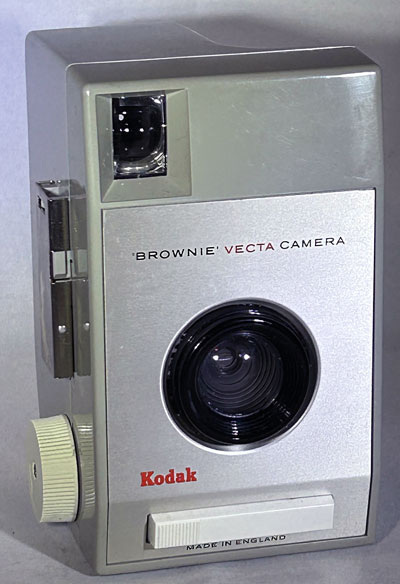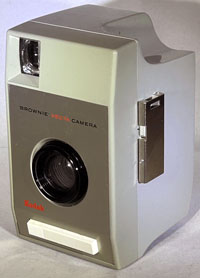Kodak 'Brownie' Vecta
Specification

| Manufacturer | : | Kodak |
|---|---|---|
| Produced | : | 1963 - 1966 |
| Classification | : | Medium Format |
| Body Type | : | Box |
| Construction | : | Plastic |
| Film Type | : | 127 |
| Film Width | : | 46mm |
| Image Size | : | 40 x 65 mm |
| No. of Images | : | 8 |
| Lens Type | : | Meniscus |
| Focal Length | : | 60mm |
| Focus Type | : | Fixed |
| Focus Range | : | 10ft to inf |
| Aperture Type | : | Fixed |
| Aperture | : | f/14 |
| Shutter Type | : | Leaf |
| Shutter Speeds | : | I*(1/50 sec) |
| Size (w x h x d) | : | 75 x 110 x 72mm |
| Weight | : | 195g |
| * Measured on this camera | ||
Art Deco Credentials

![]()
![]()
Acceptable: Modest and restricted
- Produced after the main Art Deco period;
- Minimalist, geometric design;
- Bold, clean lines;
- Stylized simplicity;
Description
The Kodak 'Brownie' Vecta was designed by Kenneth Grange, a renowned British industrial designer. It was introduced in 1963 and production continued until 1966.
Its design is widely appreciated for being-
- Geometric
- Featuring clean lines, bold form, and stylized simplicity
- Made from molded plastic with a minimalist, sculptural quality
It features Art Deco principles like: emphasis on form; use of stylized, streamlined shapes; aesthetic integration of function and design.
However, the Vecta also reflects the Mid-century Modern ethos including: use of new materials (plastic); a move toward mass production; and a minimal, practical approach to design.
The simple design features only a knob for turning on the film, a red widow to view the frame numbers and a horizontal bar on the front, used as a shutter release.
It has a locking mechanism so the next shot cannot be taken until the camera is wound on, thus avoiding double exposure.
The body is sculptured making it easy to hold.
How to Use
This camera takes 127 film which is still available from select outlets - search for 'Rera Pan 100-127' which is a black & white film. For those photographers in the UK, try Nick & Trick photographic services. If you want to use a particular type of film which is not available commercially, then you can cut your own 127 film from any 120 film. See my page on 'How to cut 127 film from 120 film'.
As the shutter speed is only 1/50s, it is advisable to hold it against a wall or other solid object to get shake free images. For quick snapshots, hold it firmly against your face.
If you don't want to bother with an exposure meter, follow the guide shown. It is based on the 'Sunny 16' rule. Film is so forgiving and will produce acceptable results even when overexposed by 2 or 3 stops or underexposed by 1 stop.
The tables assume that the sun is at least 30 degrees above the horizon - that's 10am - 5pm on a summers day (May - August) in the UK.
Remember that the exposure guide in the manual may not be helpful as it is based on the use of old film with a low ISO value.
Using ISO 100/125 film - shutter speed 1/50s
| Weather Conditions | Shadow Detail | Aperture | Exposure |
|---|---|---|---|
 Sunny SunnySnow/Sand | Dark with sharp edges | f/14 | +2 Stops Overexposed Acceptable |
 Sunny Sunny | Distinct | f/14 | +1 Stops Overexposed Acceptable |
 Slight Overcast Slight Overcast | Soft around edges | f/14 | Good |
 Overcast Overcast | Barely visible | f/14 | -1 Stop Underexposed Acceptable |
 Heavy Overcast Heavy Overcast | None | f/14 | -2 Stops Underexposed Not Acceptable |
 Open Shade Open Shade/Sunset | None | f/14 | -3 Stops Underexposed Not Acceptable |